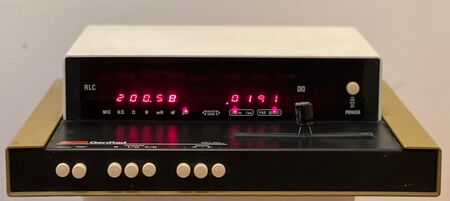1657: Difference between revisions
Jump to navigation
Jump to search
No edit summary |
No edit summary |
||
| Line 1: | Line 1: | ||
[[File:1657 | [[File:1657 3.jpg|thumb|450px|right|GenRad 1657 Digibridge]] | ||
The '''General Radio 1657 Digibridge''' is a digital RLC meter, [[introduced in 1976]] [https://www.ietlabs.com/genrad_history/genrad_museum <sup>1</sup>]. | The '''General Radio 1657 Digibridge''' is a digital RLC meter, [[introduced in 1976]] [https://www.ietlabs.com/genrad_history/genrad_museum <sup>1</sup>]. | ||
| Line 23: | Line 23: | ||
1657 1.jpg | 1657 1.jpg | ||
1657 2.jpg | 1657 2.jpg | ||
1657 3.jpg | |||
</gallery> | </gallery> | ||
[[Category:Impedance measurement]] | [[Category:Impedance measurement]] | ||
Revision as of 07:56, 18 December 2023

The General Radio 1657 Digibridge is a digital RLC meter, introduced in 1976 1.
Specifications
please add
Manuals
Links
- Henry P. Hall
- US Patent 4342089, Henry P Hall, Method of and apparatus for automatic measurement of circuit parameters with microprocessor calculation techniques. Filed Dec 12, 1979; Granted July 27, 1982
- How to measure R, C, L using vintage LCR meter @ YouTube
Internals
The 1657 applies a sine wave to the measured device and a precision resistor in series. The average voltage across each is measured using four different phases relative to the input sine wave, for a total of eight measurements. From these, the resistive and reactive components of the tested device can be calculated and displayed.
The 1657 uses a 6503 CPU, which is a 28-pin version of the 6502 with the same instruction set, but fewer address lines. The 1657's firmware is contained in a 2Kx8 ROM, in later versions a 2716 EPROM. A 128-byte SRAM holds scratchpad and the stack.


